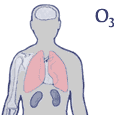
Nitrogen Dioxide

Ozone

Carbon Monoxide

Sulfur Dioxide

Particulate Matter

Lead
|
 
Ozone - O3
At ground level, ozone is the major component of smog. Unlike ozone in the upper layer of the atmosphere that serves as a lifesaving sunscreen, protecting the Earth from ultraviolet rays, low-lying ozone is harmful to us and other life. This pungent, colorless gas is created when other pollutants from human activities combine together. When the sun is shining, nitrogen oxides (NOx), volatile organic compounds (VOCs), and oxygen (O2) react together chemically to make ozone, a new compound of 3 oxygen atoms. Because ozone can only be created in sunlight, it increases during the day and decreases when the sun goes down. But in some areas, like the Sierra, ozone levels stay elevated even at night. When all the polluting ingredients are present in hot, dry weather, ozone often reaches unhealthy levels.
Where
Ozone is produced naturally in small amounts from NO2 and VOCs produced by lightning, forest fires, and vegetation. However, human-caused emissions of nitrogen oxides and volatile organic compounds are producing ozone levels that continue to exceed air quality standards across the nation. Vehicle emissions from the incomplete burning of gasoline are responsible for 60% of ozone's ingredients. Gasoline evaporation during refueling, paint and industrial spray painting operations and other fossil fuel combustion emit the rest.
Effects
Ozone damages lung tissue, reduces lung function, sensitizes the lungs to other irritants and aggravates chronic respiratory disease. Children, senior citizens and asthmatics, as well as athletic and active people are particularly susceptible to ozone in the air. Ozone also damages crops and forests by interfering with photosynthesis and weakening resistance to insects and disease. In the San Joaquin Valley alone ozone causes more than $300,000,000 ($300 million) of agricultural damage a year.

Back to Criteria Pollutants In Depth
|

O3 attacks the lungs

Volatile Organic Compounds

Pollutants Add Up To Smog
|
